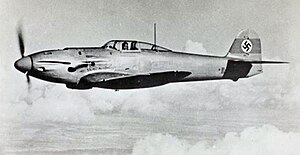Heinkel He 112
| Heinkel He 112 | |
|---|---|

|
|
| Type: | Fighter plane |
| Design country: | |
| Manufacturer: | |
| First flight: |
September 1935 |
| Commissioning: | |
| Production time: |
1935-1938 |
| Number of pieces: |
104 |
The Heinkel He 112 was a German fighter aircraft that was commissioned by Ernst Heinkel as a project for the RLM's fighter aircraft competition in October 1935. It was designed by the brothers Walter and Siegfried Günter .
Development history
The aim was to find a modern successor model for the outdated German double-decker fighters ( Heinkel He 51 and Arado Ar 68 ). The tests and the comparison with the competitors Bf 109 , Fw 159 and Ar 80 were carried out by the See trial site in Travemünde . The V2 D-IHGE crashed on April 15, 1936. The open pilot's seat was criticized by the commission, even if it was welcomed by the pilots and was completely common at the time. It was also criticized that the landing gear was chipped in the wings. This contradicted a requirement of the tender, which demanded that the fuselage should be able to move independently even without mounted wings and that it should be able to be loaded onto railway wagons of the Deutsche Reichsbahn in compliance with the loading gauge . This should facilitate the maintenance of aircraft at field airfields; It should also enable the changing of damaged wings without special devices and also facilitate the recovery and retrieval of aircraft that have landed outside. The narrow track width of the landing gear resulting from this requirement led to the Messerschmitt Bf 109 , the winner of the tender, but later often to many take-off and landing accidents, especially in crosswinds. This requirement was therefore no longer made in all further tenders.
Heinkel and Bayerische Flugzeugwerke (from 1938 Messerschmitt AG ) first secured orders for ten pre-production aircraft of the types He 112 and Bf 109, as the commission could not come to a clear judgment for the time being.
In a later comparison flight, the RLM decided in favor of the Bf 109 as the new standard fighter of the German Air Force , since Heinkel was to concentrate on the He 111 bomber , and the Bf 109 was easier and, above all, much cheaper to produce than the He 112.
However, the further development of the He 112 A to version B was continued. This introduced the Jumo 210Ea engine and was equipped with two 20 mm MG FF and two 7.92 mm MG 17s .
However, due to the decision of the RLM for the Bf 109, the He 112 was released for export. Customers included the Imperial Japanese Air Force .
From December 1936 on, the ninth prototype (V9) was tested in action by the Condor Legion in Spain. It was destroyed in a crash landing in July 1937.
The following versions were built:
Construction figures of the He 112 1935–1938 :
| version | TOTAL | Work number |
|---|---|---|
| Prototypes | 3 | 1290-1292 |
| A-0 | 17th | 1951-1960, 2248-2254 |
| B-0 | 4th | 1944, 1969, 1973, 1974 |
| B. | 80 | 2001-2080 |
| TOTAL | 104 |
A total of 13 prototypes were used to develop the He 112.
Exports of the He 112 :
| Country | number | Years |
|---|---|---|
| Japan | 30th | 1937-1938 |
| Spain | 19th | 1939 |
| Hungary | 3 | 1939 |
| Romania | 30th | 1939-1940 |
| TOTAL | 82 |
A license for the reproduction was also sold to Hungary ( Csepel - Manfréd Weiss ). The local government ordered twelve machines from the company, of which only three were delivered.
The last He 112s were in service in Spain until the 1950s. Today there is no machine left.
Rocket flight
As part of the research into liquid rocket propulsion, some He-112 cells were converted for the installation of additional rocket motors and, after initial problems, were flown successfully. The test pilot was Erich Warsitz . The result of these tests was the world's first aircraft with He 176 liquid rocket propulsion and the use of Walter start-up rockets on overloaded He 111 bombers.
Technical specifications
| Parameter | Data of the Heinkel He 112 B-1 |
|---|---|
| crew | 1 |
| Engine | a twelve-cylinder V-engine Junkers Jumo 210 G |
| Starting power | 700 hp at 2750 min -1 0 m |
| rated capacity | 700 hp at 2750 min -1 0 m |
| rated capacity | 675 hp at 2700 min -1 to 4700 m |
| Full pressure height | 1000 m |
| specific fuel consumption | 217 g / PSh |
| Propeller | adjustable VDM metal propeller with 3.1 m diameter |
| span | 9.1 m |
| length | 9.3 m |
| Altitude with running propeller | 3.8 m |
| Wing area | 17.0 m² |
| Wing loading | 132 kg / m² |
| Power load | 3.21 kg / hp |
| Empty mass | 1620 kg |
| additional equipment | 288 kg |
| Preparation mass | 1848 kg |
| crew | 100 kg |
| fuel | 230 kg |
| Lubricant | 20 kg |
| Payload (ammunition) | 52 kg |
| Flight mass | 2250 kg |
| Maximum speed at a height of 0 m | 430 km / h |
| Top speed at an altitude of 4700 m | 510 km / h |
| Top speed at 6000 m altitude | 485 km / h |
| Walking speed at a height of 0 m | 380 km / h |
| Cruising speed at an altitude of 4000 m | 430 km / h |
| Walking speed at an altitude of 6000 m | 395 km / h |
| Landing speed | 135 km / h |
| optimal range at Vmax at an altitude of 4000 m | 760 km |
| optimal range at Vr at an altitude of 4000 m | 1000 km |
| optimal range | 1150 km |
| Climbing time to an altitude of 1000 m | 1.3 min |
| Ascent time to 2000 m altitude | 2.6 min |
| Ascent time to 6000 m altitude | 9.5 min |
| Summit height | 9500 m |
| Taxiway at the start | 300 m |
| Take-off distance up to 15 m | 570 m |
| Landing distance from a height of 15 m | 500 m |
| Armament | 2 × MG 17 rigidly directed forward in the fuselage, 2 × MG FF rigidly directed forward in the area |
See also
literature
- Heinkel - Chronicle and data sheets of the Heinkel-Flugzeugbau company. Reprint of the Heinkel type sheets, AVIATIC Verlag, ISBN 3-925505-08-3 .
- Hans-Peter Dabrowski: Single-seater hunting He 112. Podzun-Pallas, Volume 159, ISBN 3-7909-0567-4 .
- Documents from the Federal Archives / Military Archives Freiburg



